Blog

What is Brake Fade?
When you press the brake pedal to slow down, multiple individual components and systems work together to stop or slow the vehicle down. Every day, millions of drivers successfully navigate the highways and roadways without problems. However, if the brakes appear to fail, the results can be disastrous and extremely disheartening. This situation is commonly referred to as brake fade, which is a temporary reduction or the full loss of braking power.
Brake fade can be temporary — lasting only a split second in most cases. But those precious moments can mean the difference between a successful stop, or a serious accident. In order to clarify some of the misunderstandings associated with this situation, we’d like to articulate some of the facts about brake fade, what causes it, and what you can do to reduce the potential of this happening to you.
What is Brake Fade?
In order to slow a vehicle down, the brake pad and rotor must create mutual friction in the braking system. If the brakes are applied and this does not occur, it’s referred to as brake fade. When brake fade happens, it results in unexpected or inconsistent braking — typically increasing stopping distance and the likelihood of an accident. Brake fading is commonly caused by the overheating of a brake pad and can happen on cars, trucks, SUVs, and motorcycles. Since brake fade occurs from overheating, it’s usually temporary and the brake system will return to normal function once the brake pads and rotor have cooled down.
What are the Different Types of Brake Fade?
There are two specific types of brake fade common with cars, trucks, and SUVs sold in the US.
Green Fade: The most common type of brake fade is called Green Fade, or early-life brake fade. This situation usually develops when new brake pads and/or brake rotors are installed. When brake pads are replaced, it might take some time to for the new components to ‘settle in’ or properly align. Some mechanics call this period the ‘bedding in’ period. Under normal city driving conditions, it will take 500 miles for brake pads and rotors to properly align.
Dynamic Fade: Dynamic brake fade, or stop brake fade, is more serious and typically due to incorrect or faulty brake pad components. Brake components are unique to every year, make and model. When a brake pad or rotor from a different year, make or model of vehicle is installed on your car, truck or SUV, the potential for dynamic brake fade increases. Dynamic brake fade can also be caused by improper installation — such as the brake caliper being improperly torqued.
Brake Fluid Fade: Brake fluid is part of the brake caliper. The brake caliper heats up as it pushes the brake pads into contact with the brake disc using brake fluid. Both the fluid and the caliper heat up from this process, which causes bubbles to form from boiling if it gets too hot. This reduces the total amount of fluid and prevents full braking power, as air is easier to compress than a liquid. Brake fluid should be replaced as recommended by your vehicle’s service manual — the older the fluid, the more likely it is to boil.
Posted on February 2019,07 // Author: Admin